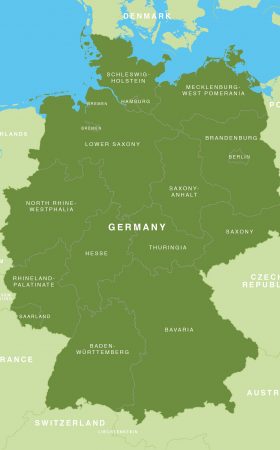Facts About Germany
Location and Geography


Germany, officially the Federal Republic of Germany, is a country in Central and Western Europe. Covering an area of 357,022 square kilometers (137,847 sq mi), it lies between the Baltic and North seas to the north, and the Alps to the south.
Elevation ranges from the mountains of the Alps (highest point: the Zugspitze at 2,962 meters (9,718 ft)) in the south to the shores of the North Sea (Nordsee) in the northwest and the Baltic Sea (Ostsee) in the northeast. Between lie the forested uplands of central Germany and the low-lying lands of northern Germany, traversed by some of Europe’s major rivers such as the Rhine, Danube and Elbe.
Germany shares borders with nine European countries, second only to Russia: Denmark in the north, Poland and the Czech Republic in the east, Switzerland (its only non-EU neighbor) and Austria in the south, France in the southwest and Belgium, Luxembourg and the Netherlands in the west. Germany also shares a maritime border with Sweden in the north and the United Kingdom in the northwest.
History and Population
The concept of Germany as a distinct region in central Europe can be traced to Roman commander Julius Caesar, who referred to the unconquered area east of the Rhine as Germania, thus distinguishing it from Gaul (France), which he had conquered. The victory of the Germanic tribes in the Battle of the Teutoburg Forest (AD 9) prevented annexation by the Roman Empire, although the Roman provinces of Germania Superior and Germania Inferior were established along the Rhine. Following the Fall of the Western Roman Empire, the Franks conquered the other West Germanic tribes. When the Frankish Empire was divided among Charles the Great’s heirs in 843, the eastern part became East Francia. In 962, Otto I became the first Holy Roman Emperor of the Holy Roman Empire, the medieval German state.
In the Late Middle Ages, the regional dukes, princes, and bishops gained power at the expense of the emperors. Martin Luther led the Protestant Reformation within the Catholic Church after 1517, as the northern states became Protestant, while the southern states remained Catholic. The two parts of the Holy Roman Empire clashed in the Thirty Years’ War (1618–1648), which was ruinous to the twenty million civilians living in both parts. The Thirty Years’ War brought tremendous destruction to Germany; more than 1/4 of the population and 1/2 of the male population in the German states were killed by the catastrophic war. 1648 marked the effective end of the Holy Roman Empire and the beginning of the modern nation-state system, with Germany divided into numerous independent states, such as Prussia, Bavaria, Saxony, Austria and other states, which also controlled land outside of the area considered “Germany”. After the French Revolution and the Napoleonic Wars from 1803–1815, feudalism fell away and liberalism and nationalism clashed with reaction. The German revolutions of 1848–49 failed. The Industrial Revolution modernized the German economy, led to the rapid growth of cities and the emergence of the socialist movement in Germany. Prussia, with its capital Berlin, grew in power. German universities became world-class centers for science and humanities, while music and art flourished. The unification of Germany (excluding Austria and the German-speaking areas of Switzerland) was achieved under the leadership of the Chancellor Otto von Bismarck with the formation of the German Empire in 1871. This resulted in the Kleindeutsche Lösung, (“small Germany solution”, Germany without Austria), rather than the Großdeutsche Lösung, (“greater Germany solution”, Germany with Austria). The new Reichstag, an elected parliament, had only a limited role in the imperial government. Germany joined the other powers in colonial expansion in Africa and the Pacific.
In 1989, the Berlin Wall was opened, the Soviet Union collapsed, and East Germany was reunited with West Germany in 1990. In 1998–1999, Germany was one of the founding countries of the eurozone. Germany remains one of the economic powerhouses of Europe, contributing about one-quarter of the eurozone’s annual gross domestic product. In the early 2010s, Germany played a critical role in trying to resolve the escalating euro crisis, especially concerning Greece and other Southern European nations.
Society and Culture
The culture of Germany has been shaped by major intellectual and popular currents in Europe, both religious and secular. Historically, Germany has been called Das Land der Dichter und Denker (the country of poets and thinkers).
There are a number of public holidays in Germany. The country is particularly known for its Oktoberfest celebrations in Munich, its carnival culture and globally influential Christmas customs known as Weihnachten. 3 October has been the national day of Germany since 1990, celebrated as the German Unity Day. The UNESCO inscribed 38 properties in Germany on the World Heritage List.
Germany was the world’s second most respected nation among 50 countries in 2013. A global opinion poll for the BBC revealed that Germany is recognized for having the most positive influence in the world in 2011, 2013, and 2014.
Cost of Living
Compared to some other European countries, Germany is not very expensive. The costs of food, housing, clothing and cultural activities are slightly higher than the EU average. On average, students in Germany spend around 850 euros per month on living costs. The largest expense is rent.
Being one of the richest countries in the world, living expenses in Germany are not as high as any one would expect. In fact, Germany is ranked the 15th highest in terms of cost of living.
Germany’s standard of living, public transport, healthcare, and education systems are excellent and shopping bills in major German cities are often significantly less than other major European cities, resulting in the cost of living in Germany being lower than major European cities such as Paris, London, Rome, Brussels, and Zurich. In terms of quality of life and well-being, Germany ranks above average in the OECD Better Life Index.
Education System
Education in Germany is primarily the responsibility of individual German states, with the federal government playing a minor role. Optional Kindergarten (nursery school) education is provided for all children between one and six years old, after which school attendance is compulsory. The system varies throughout Germany because each state decides its own educational policies. Most children, however, first attend primary or elementary school for 4 years from the age of 6 to 9. Germany’s secondary education is separated into two parts, lower and upper. Lower-secondary education in Germany is meant to teach individuals basic general education and gets them ready to enter upper-secondary education. In the upper secondary level Germany has a vast variety of vocational programs.
German secondary education includes five types of school. The Gymnasium is designed to prepare pupils for higher education and finishes with the final examination Abitur, after grade 13.
From 2005 to 2018 a school reform known as G8 provided the Abitur in 8 school years. The reform failed due to high demands on learning levels for the children and were turned to G9 in 2019. Only a few Gymnasiums stay with the G8 model. Children attend usually Gymnasium from 10 to 18 years. The Realschule has a broader range of emphasis for intermediate pupils and finishes with the final examination Mittlere Reife, after grade 10; the Hauptschule prepares pupils for vocational education and finishes with the final examination Hauptschulabschluss, after grade 9 and the Realschulabschluss after grade 10. There are two types of grade 10: one is the higher level called type 10b and the lower level is called type 10a; only the higher-level type 10b can lead to the Realschule and this finishes with the final examination Mittlere Reife after grade 10b. This new path of achieving the Realschulabschluss at a vocationally oriented secondary school was changed by the statutory school regulations in 1981 – with a one-year qualifying period. During the one-year qualifying period of the change to the new regulations, pupils could continue with class 10 to fulfil the statutory period of education.
The format of secondary vocational education is put into a way to get individuals to learn high skills for a specific profession. “Most of Germany highly skilled workforce has gone through the dual system of vocational education and training also known as V.E.T.”. Many Germans participate in the V.E.T. programs. These V.E.T. programs are partnered with about 430,000 companies, and about 80 percent of those companies hire individuals from those apprenticeship programs to get a full-time job. This educational system is very encouraging to young individuals because they are able to actively see the fruit of their loom. The education system is encouraging to individuals because they know that most likely a job will be waiting for them when they are done with school. The skills that are gained through these V.E.T. programs are not easily transferable and once a company commits to an employee that came out of these vocational schools, they have a commitment to each other. Germany’s V.E.T. programs prove that a college degree is not necessary for a good job and that training individuals for specific jobs could be successful as well.
Other than this, there is the Gesamtschule, which combines the Hauptschule, Realschule and Gymnasium. There are also Förder- or Sonderschulen. One in 21 pupils attends a Förderschule. Nevertheless, the Förder- or Sonderschulen can also lead, in special circumstances, to a Hauptschulabschluss of both type 10a or type 10b, the latter of which is the Realschulabschluss.
Many of Germany’s hundred or so institutions of higher learning charge little or no tuition by international comparison. Students usually must prove through examinations that they are qualified.
To enter university, students are, as a rule, required to have passed the Abitur examination; since 2009, however, those with a Meisterbrief (master craftsman’s diploma) have also been able to apply.
A special system of apprenticeship called Duale Ausbildung (the dual education system) allows pupils on vocational courses to do in-service training in a company as well as at a state school.
Information Specific to International Students
Germany is becoming a very popular study destination standing alongside the US, the UK, Canada and Australia. Consequent to this high attractiveness the country has reached its long-term of welcoming 350,000 international students, by 2020, three years earlier in 2017.
There are now approximately more than 400,000 International Students studying in Germany according to the 2019 Statistics
The main reason to study in Germany is for the free tuition! German government policy means free university tuition for both domestic and international students. Most, but not all, German universities are free of tuition fees.

